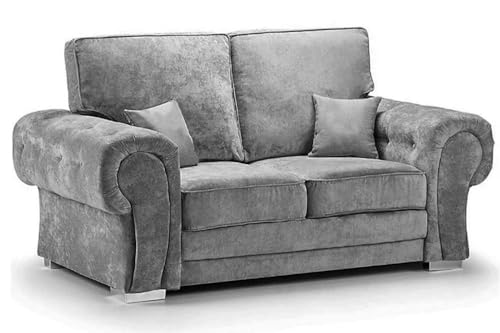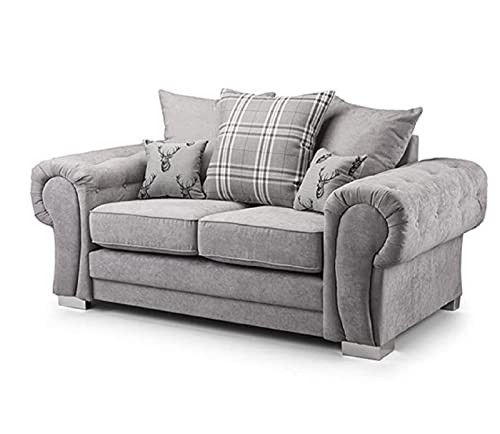Guide To 2 Seater Leather And Fabric Sofa: The Intermediate Guide The …
페이지 정보

본문
 Choosing Between a 2 Seater Leather and Fabric Sofa
Choosing Between a 2 Seater Leather and Fabric SofaIt can be difficult to decide between fabric and leather when you are searching for a new sofa. This is especially true if you don't have much furniture experience.
If you have kids or reside in apartments, the leather option may be right for you. It's easy to wipe down and looks great in most homes.
Comfort
A sofa is the focal element of the majority of living spaces and is a major purchase. You want one that you can sit on for hours and looks good, is in line with your room style and can stand the test of time. The decision between fabric or leather can be confusing, but it is important to evaluate your needs, lifestyle and budget before making a choice.
Leather is a premium, luxurious material that exudes style and elegance in any home. It is durable and stain-resistant, it is resistant to children and pets, and will last for a long period of time with proper maintenance. It can be costly initially and may require regular conditioning to prevent cracks or peeling.
Fabric sofas are available in a vast variety of styles, colors and fabrics. They can be cheaper than leather ones. They are also soft and more cosy, and can be "broken into" right from the beginning. They could be more vulnerable to dust mites and hairs from pets and require frequent cleaning. There are now hypoallergenic fabrics as well as new technologies that are available.
small fabric 2 seater sofa sofas 2 seater fabric can last for up to 15 years if they're properly maintained. Regular vacuuming and deep cleaning will help to keep the fabric clean and free of odours and stains. Like leather, they are susceptible to sagging and flattening over time. In addition, many fabrics are treated with chemicals to make them stain-resistant and flame retardant. They can release volatile organic compounds that can alter indoor air quality and cause allergies.
Durability
When buying sofas, we usually select fabrics that are extremely robust, which is crucial when you have pets or children. You don't want to pay an excessive amount upfront and be left with buyer's remorse after the first spill or crowbarred claws. Similarly you don't want to purchase something that is cheap but can't withstand everyday use.
Leather, on the other hand, is extremely resilient and has an incredible strength for tears. It can last up to 4 times longer than fabric, and it is naturally resistant to cracking, fade and flaking over time. It can be treated to replenish its natural oils, and make it look like new.
Fabrics are a more affordable alternative and are available in a range of different colors patterns, textures, and patterns to match any interior design scheme. Fabrics are easier to clean and can stand up to some wear and tear. However, they can fade over time and are more prone to moisture.
Microfiber is a good option for its durability and comes in a wide range of colors, but it's not as tough as genuine leather and will not be able to take the punishment of scratches. It is an excellent choice for families because of its resistance to spills and stains. It's also easy to clean with a damp cloth.
Suede is more difficult to clean and repair than leather. It's shape can change and appear rough if not regularly maintained. It is also a thin material, so it might not be as durable as cowhide and sheepskin leather.
Allergens
The material your sofa is made of can have a major impact on your allergies, so it's crucial to know the various options that are available. Fabrics are prone to retaining allergens like dust mites and pet dander which can cause symptoms such as hay fever, asthma, rhinitis and eczema. This is because these fabrics create the perfect environment in which they can thrive.
Leather, on the other hand isn't susceptible to the accumulation of allergens, and can provide consistent comfort regardless of the season. It can also cause skin irritation in those who suffer from contact dermatitis, or are sensitive to chemicals used in tanning. Utilizing vegetable-tanned leather and ensuring an active skincare routine are essential for mitigating skin reactions.
Both leather and fabric sofas are durable, but the material you choose will have a significant effect on how your couch holds up to wear. A good quality small fabric 2 seater sofa will stand up to daily use without fading or sagging and will withstand spills and body oils effortlessly. Modern fabric couches are often equipped with stain resistant treatments to make cleaning easy.
While you might not be able completely avoid an allergic reaction to the leather in your sofa, you can help to reduce allergens by having a lint roll near and regularly vacuuming your living space. This will lessen the amount of dirt, pet hair and dust mites you find on your sofa. If you're still experiencing issues with allergies, try replacing your sofa with a hypoallergenic model. For example, a leather sofa made of vinyl or synthetic leather is less likely to trap dust mites and pet dander. It also can help you breathe more easily.
Scratches
When you are buying a leather sofa, it is crucial to consider how much wear and tear you can anticipate from it. The finish, colour and quality of the leather are all crucial factors in the length of time a sofa will last. You also want to ensure that the couch is strong enough to withstand spillages and other accidents. This can be accomplished by choosing a couch with a solid wood frame and high density foam cushions.
Leather is susceptible to being scratched due to a number of reasons, such as stretching and marking the territory or the reliving of stress. Scratches are of varying severity. They vary from minor surface scratches, to severe cuts or punctures. Minor scratches can be treated by applying a conditioner for leather to the affected area. This will restore the balance between oil and moisture in the leather and stop it from drying out or cracking. Deep cuts and scratches may require a different treatment, depending on the amount of damage.
It is recommended for cat owners to trim their cats' nails regularly. This will prevent them from scratching the couch. You can also redirect your cat's scratching habit by offering alternative scratching surfaces, such as cardboard or sisal rope. You can also apply a pet-safe furniture polish that you can apply using a the help of a soft clean cloth.
In addition to cleaning your leather couch regularly, it's recommended to keep it away from direct sunlight and sources of heat, as this can dry out the leather. This could cause it to crack and is often difficult to repair and often requires reupholstery. Make use of a leather conditioner in order to keep the leather soft.
Smell
Leather couches can smell different from fabric. It's because leather is porous, and will absorb odors like smoke, body odors, or food. The good thing is that odors usually disappear over time, particularly when you employ a non-toxic, fragrance free cleaner.
If the smell is overwhelming it could indicate that something is wrong with the foam. This is usually caused by the chemical off-gassing process of polyurethane based on petroleum. If you are concerned about this then seek out couches made from CertiPUR US certified natural latex.
Another method to determine faux leather is by feeling for bumps or texture on the back of the sofa. This is a telltale sign that it's bonded instead of genuine top grain leather. You can also conduct a visual inspection by tilting the couch to its side to check if you see any exposed upholstery backing. If so see any, it's likely a synthetic material, such as polyurethane or polyester, which has a distinct smell than real leather.
While a leather couch is more likely to be prone to absorbing smells, the most effective method to avoid this is by regularly cleaning your sofa. This keeps it looking good and smelling good, as well preventing it from becoming brittle or brittle over time. Begin by vacuuming and dusting, then wiping the couch with baking soda (a natural method of eliminating smells). You should do this at least once every two weeks or more in order to get rid of any dirt and dust build up. Then, apply a leather conditioner to preserve the color and texture.

- 이전글8 Tips To Improve Your Jogging 3 Wheel Stroller Game 24.10.27
- 다음글How Lightweight 3 Wheel Pushchair Influenced My Life For The Better 24.10.27
댓글목록
등록된 댓글이 없습니다.


